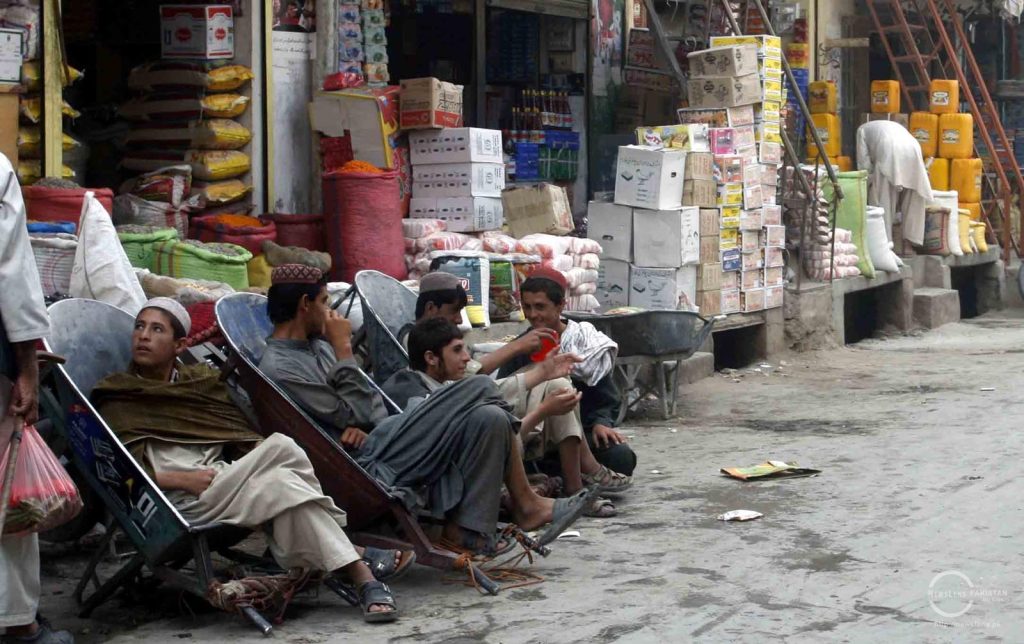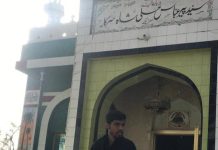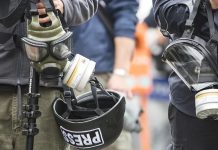
Lahore: Irfan and Rizwan, two real brothers of 9 and 10, hold a medium sized tray stacked with Khataies (traditional cookies from Punjab usually sold in winter) and can be seen in the streets in nights to sell cookies. They are not common vendors but cultured boys, studying in local public school.
They told News Lens Pakistan, “Our school begins at 12 noon. We do our homework in the morning and at night we help our father and sell cookies with him on streets.” They said they were very poor and their father alone could not support the family. “We are four siblings and it is difficult for my father to manage the finances of the house alone. My mother is a domestic worker. Being elders in the family, both of us also contribute,” said Rizwan, the oldest of the two, and hardly ten years old.
Another child, Asia Bilal, from Kahror Pakka in Southern Punjab, was sitting with her employees’ eight- year old daughter Mahak on the bench of Model Town Park, Lahore. Asia told New Lens Pakistan that her father is a Rikshaw driver and they were six siblings. Except the eldest sister who is now married, each of them is working. She was hired by a family in Jubilee Town Lahore on a meagre Rs 2,000 per month for domestic chores.
“I go to madrassa (seminary) every day with my owner’s daughter, Mehak. Even before I came to Lahore, I was going to a madrassa in my village. I remember going to school once when very young but then my parents shifted me to the madrassa, My elder sister and brother also dropped out of school very early to assist our parents in earning,” Asia told New Lens Pakistan.
These are just a few examples of the ineffective education system in Punjab. Even though the Punjab government is dedicated to providing free education for all; the strategy it has employed for that, the experts says, would hardly bear the desired results.
Amir Riaz, an independent education researcher, a Punjab Text Book Board (PTB) consultant on content analysis and an author of a research report on PTB textbooks titled “What are we teaching to our children?” termed the Punjab government’s plan “Parho Punjab Barho Punjab” aimed at enrolling every child in school in Punjab by 2018, unrealistic.
“Though Punjab government has enhanced the education budget and has raised the salaries of the teachers, they have not grappled with the real issue. Unless the government appendices general education with skill development the dropout rate that begins falling sharply after class five would not be controlled. Basic education level should be reduced from class 10 to class six whereupon children should start getting a skill-based education along with the general education. Usually when parents of a poor household see their children in class five getting nowhere they take them out and put them on a job where they learn vocations while getting some salary.
“The idea is to integrate skill-based education with general education. The model of post-school technical and vocational training used by TEVTA and poly-technical institutes will not improve the statistics of out-of-school children, nor will it force parents to wait until they reach the desired age to get training in these institutes. Poverty and illiteracy are two sides of the same coin, which gives rise to child labour, a scourge Pakistan has still not been able to eliminate,” said Riaz
Riaz further added that the two brothers mentioned in this story might probably leave school before matriculation. About Asia, he said such children are a common sight in Pakistan and no legislation had been able to put an end to this scourge. He said lack of political will and loopholes in capacity building are the main causes behind rising child labour, illiteracy, and poverty.
According to the United Nations Children’s Fund report, ‘State of Children in Pakistan,’ released in May 2015, Pakistan has failed to eliminate child labour. The report admonishes the lawmakers of the country for showing negligence in confirming to the treaty the country has signed with the United Nation’s convention on the Right of the Child. The absence of any legal framework contributes to the rising child labour trend in the country the report further elaborates.
The convention on the Rights of the child views children as human beings “with a distinct set of rights instead of as passive objects of care and charity.”
After 18th Amendment education has become a provincial subject, however, it is the federal government jurisdiction to ratify conventions signed under United Nation convention.
Governments all over Pakistan have increased their education, budget. However, it is one thing to allocate funds and another to put it on use. Usually, education budgets are siphoned off to other activities such as building roads and bridges.
In Punjab during 2014-15, Rs 48.38 billion were allocated for school education but only 28.062 billion rupees was spent.
In 2013-14, the Punjab government spent Rs 37.43 billion of the allocated 41.70 billion rupees.
When News Lens Pakistan contacted the Executive District Officer (EDO) Education Lahore, Pervaiz Akhtar to acquire about the under-utilized budget for consecutive two years, he had no straight answer except that the government tries its best to use the budget fully every year.
Under the Punjab Free and Compulsory Education Act 2014, the provincial government is responsible to provide free education to every child between the ages of 5 to 16 of the province.
According to the Pakistan Education Statistics Report 2014, 2.9 million children are still out of school in Punjab.



